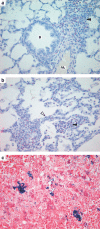Mutation at the Evi1 locus in Junbo mice causes susceptibility to otitis media
- PMID: 17029558
- PMCID: PMC1592239
- DOI: 10.1371/journal.pgen.0020149
Mutation at the Evi1 locus in Junbo mice causes susceptibility to otitis media
Abstract
Otitis media (OM), inflammation of the middle ear, remains the most common cause of hearing impairment in children. It is also the most common cause of surgery in children in the developed world. There is evidence from studies of the human population and mouse models that there is a significant genetic component predisposing to OM, yet nothing is known about the underlying genetic pathways involved in humans. We identified an N-ethyl-N-nitrosourea-induced dominant mouse mutant Junbo with hearing loss due to chronic suppurative OM and otorrhea. This develops from acute OM that arises spontaneously in the postnatal period, with the age of onset and early severity dependent on the microbiological status of the mice and their air quality. We have identified the causal mutation, a missense change in the C-terminal zinc finger region of the transcription factor Evi1. This protein is expressed in middle ear basal epithelial cells, fibroblasts, and neutrophil leukocytes at postnatal day 13 and 21 when inflammatory changes are underway. The identification and characterization of the Junbo mutant elaborates a novel role for Evi1 in mammalian disease and implicates a new pathway in genetic predisposition to OM.
Conflict of interest statement
Competing interests. Part of this work was funded by GlaxoSmith-Kline.
Figures




Similar articles
-
Non-Typeable Haemophilus influenzae Infection of the Junbo Mouse.Curr Protoc Mouse Biol. 2017 Mar 2;7(1):29-46. doi: 10.1002/cpmo.24. Curr Protoc Mouse Biol. 2017. PMID: 28252201
-
FBXO11, a regulator of the TGFβ pathway, is associated with severe otitis media in Western Australian children.Genes Immun. 2011 Jul;12(5):352-9. doi: 10.1038/gene.2011.2. Epub 2011 Feb 3. Genes Immun. 2011. PMID: 21293382
-
A mutation in Nischarin causes otitis media via LIMK1 and NF-κB pathways.PLoS Genet. 2017 Aug 14;13(8):e1006969. doi: 10.1371/journal.pgen.1006969. eCollection 2017 Aug. PLoS Genet. 2017. PMID: 28806779 Free PMC article.
-
The EVI1 gene in myeloid leukemia.Leukemia. 1997 Dec;11(12):2022-31. doi: 10.1038/sj.leu.2400880. Leukemia. 1997. PMID: 9447815 Review.
-
The oncogene and developmental regulator EVI1: expression, biochemical properties, and biological functions.Gene. 2007 Jul 15;396(2):346-57. doi: 10.1016/j.gene.2007.04.012. Epub 2007 Apr 20. Gene. 2007. PMID: 17507183 Review.
Cited by
-
Current Understanding of Host Genetics of Otitis Media.Front Genet. 2020 Feb 7;10:1395. doi: 10.3389/fgene.2019.01395. eCollection 2019. Front Genet. 2020. PMID: 32117425 Free PMC article. Review.
-
Interactions between the otitis media gene, Fbxo11, and p53 in the mouse embryonic lung.Dis Model Mech. 2015 Dec;8(12):1531-42. doi: 10.1242/dmm.022426. Epub 2015 Oct 15. Dis Model Mech. 2015. PMID: 26471094 Free PMC article.
-
Mutation in Fbxo11 Leads to Altered Immune Cell Content in Jeff Mouse Model of Otitis Media.Front Genet. 2020 Feb 11;11:50. doi: 10.3389/fgene.2020.00050. eCollection 2020. Front Genet. 2020. PMID: 32117459 Free PMC article.
-
Limb development genes underlie variation in human fingerprint patterns.Cell. 2022 Jan 6;185(1):95-112.e18. doi: 10.1016/j.cell.2021.12.008. Cell. 2022. PMID: 34995520 Free PMC article.
-
Panel 2- recent advance in otitis media bioinformatics.Int J Pediatr Otorhinolaryngol. 2020 Mar;130 Suppl 1(Suppl 1):109834. doi: 10.1016/j.ijporl.2019.109834. Epub 2019 Dec 18. Int J Pediatr Otorhinolaryngol. 2020. PMID: 31899006 Free PMC article. Review.
References
-
- Davidson J, Hyde ML, Alberti PW. Epidemiologic parameters in childhood hearing loss: A review. Int J Pediatr Otorhinolaryngol. 1989;17:239–266. - PubMed
-
- Kubba H, Pearson JP, Birchall JP. The etiology of otitis media with effusion: A review. Clin Otolaryngol. 2000;25:181–194. - PubMed
-
- Bluestone CD, Klein JO. Otitis media in infants and children. Philadelphia: Saunders; 2001. 418
-
- Casselbrant ML, Mandel EM, Fall PA, Rockette HE, Kurs-Lasky M, et al. The heritability of otitis media. A twin and triplet study. JAMA. 1999;282:2125–2130. - PubMed
-
- Casselbrant ML, Mandel EM, Rockette HE, Kurs-Lasky M, Fall PA, et al. The genetic component of middle ear disease in the first 5 years of life. Arch Otolaryngol Head Neck Surg. 2004;130:273–278. - PubMed
Publication types
MeSH terms
Substances
Grants and funding
LinkOut - more resources
Full Text Sources
Other Literature Sources
Medical
Molecular Biology Databases

